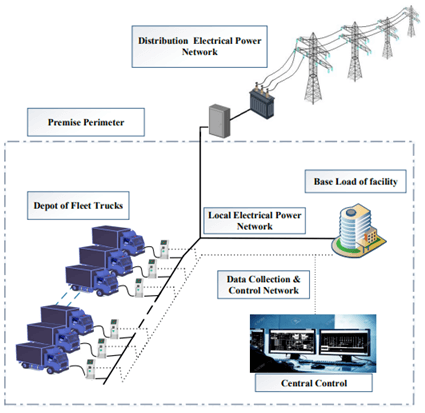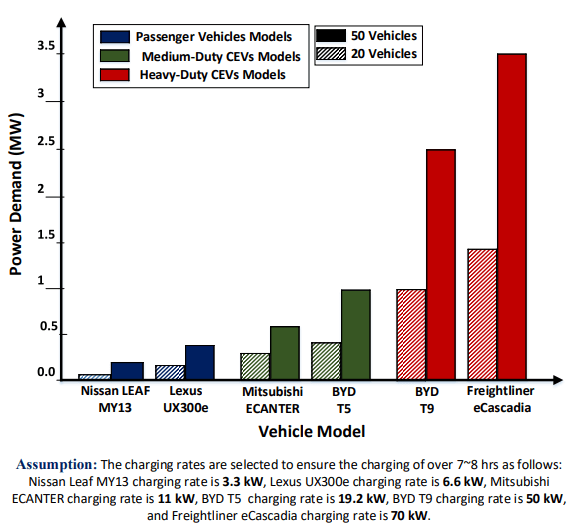Charging Challenges and Solutions for Commercial Electric Vehicles
Written by Bassam Al-Hanahi, Iftekhar Ahmad, Daryoush Habibi, and Asma Aziz
The electrification of commercial vehicles is one of the promising solutions for reducing the global emission of greenhouse gases considering that almost 40% of global CO2 emissions is contributed by the road transport sector [1]. This has motivated many governments to support zero-emission vehicles through incentives and tax reduction for transition to electric vehicles. This solution comes with many challenges and the availability of sufficient and efficient charging infrastructure is one of challenge. As compared with light passenger EV that has small battery size, Commercial Electric Vehicles (CEVs) comes with large battery size that requires high power charging infrastructure. In addition, CEVs operate on daily operational schedules that reflect daily business hours. These operational schedules may restrict the charging of CEVs as compared with EVs.
Generally, there are two major charging strategies for commercial electric vehicles, namely the return-to-base model and on-route charging. In this article, the main challenges related to these strategies are discussed along with the possible solutions.
Return-to Base Charging Strategy

Figure 1. Return-to-Base Operational Model [1].
In a ‘Return-to-Base’ charging strategy, the high-power charging infrastructure is installed at the commercial facilities (depots, yards, industrial micro-grids, etc.) to enable the full charging of CEVs outside working hours, such as overnight or between shifts. The return-to-base strategy suits a wide range of commercial services including cargo services, freight services, delivery services, utility services, and construction services. Most fleet operators prefer a return-to-base strategy because of the spatial and temporal distribution of commercial truck fleet activities and a shortage of suitable public charging stations. Therefore, a dedicated charging station is installed for each CEV that needs to be charged at the commercial facility.
Due to the high-power charging infrastructure, the simultaneous charging of commercial vehicles significantly increases the peak power demand compared to the light passenger electric vehicles. Figure 2 shows the peak power demand for simultaneous charging of passenger light vehicles, medium-duty CEVs, and heavy-duty CEVs at commercial locations. As can be noticed, the simultaneous charging of 50 heavy-duty vehicles increases peak demand to 3.5 MW compared to 1.5 MW of a similar number of passengers’ electric vehicles (EVs). With the increased adoption of EVs in the transport fleet and faster charging stations, the high-power demand may stress the local electrical distribution network, especially during the residential peak load hours. This necessitates the upgradation of local and distribution electric networks infrastructure, which requires long term planning, time and high cost to be achieved.

Figure 2. Peak Power Demands for Various EV and CEVs [1].
Increase in the electricity charges to commercial enterprises during high peak demand for charging CEVs is another prominent issue. Electricity used by commercial businesses is usually charged according to commercial and industrial electricity rates, which mainly incorporates a per-kWh energy charge plus per-peak kW demand charge. These demand charges apply to the maximum power (KW) required in any interval (typically 15 minutes) during the month. These demand charges vary moderately for the regions and significantly for the commercial facilities. Therefore, the cost of peak demand may exceed 50% of the monthly electric bill for some commercial properties [1, 2].
On-Route Charging Strategy
Although it is preferred to charge commercial vehicles at places where they are parked, their charging on the route during daily driving cycles may still be needed owing to many reasons, including the power capacity limitations of commercial facilities, and the continuous changes and deviations of the operational schedules of commercial vehicles over time. Conductive charging stations have been found to be a competitive alternative to other on-route charging means such as Inductive Power Transfer charging systems and battery swapping charging systems. Therefore, several governments and electric utilities have announced targets to deploy high-power publicly accessible and on-highway charging infrastructure.
The charging of CEVs on route at public charging infrastructure presents some challenging issues that may impact charging infrastructure operators and fleet operators both technically and economically. One of the main challenges is the daily operational schedules of CEVs that reflect daily business hours. Moreover, some fleet operators prefer to charge their vehicles on the road at locations where vehicles are typically parked during lunch breaks, between two shifts, in order to avoid any disruption to their operational schedules. Due to the diversity of the required transport missions, with different destinations and routes for commercial vehicles, there is likely a lack of public charging infrastructure at some destinations and parking locations if they cannot achieve an acceptable daily utilization rate. Moreover, this could create restrictions on maximum power available at charging infrastructure if the charging of these vehicles takes place during peak-hour periods. These factors increase the charging time and the detour time to arrive at the stations and thus disturb the operational schedules of CEVs.
Possible Solutions for Charging Challenges of CEVs
To mitigate the issues in timely charging CEVs, public charging stations dedicated to CEVs must be optimally located. The locations of public charging infrastructure should be optimized in a way that considers the diversity of transport missions of commercial vehicles, the stability limits of the grid system, and the high utilization rate of charging infrastructure. The optimization of charging infrastructure locations facilitates the charging process of commercial vehicles and thus the adoption of CEVs in commercial fleets.
Another method to address the charging challenges of CEVs is the optimal charging strategies that coordinate the charging process of commercial electric vehicles at different locations. The charging process for electrical truck fleets at commercial premises must be optimized to mitigate the impact of charging load on electrical distribution networks, as well as to reduce costs for upgrading electrical networks and demand charges. As per a case study [3], optimizing the charging of 100 FedEx Express Navistar eStar all-electric delivery vehicles with an 80 (kWh) battery pack at its commercial premise can ensure demand charge savings of approximately $11,500 per month in contrast to unmanaged charging. The charging process of commercial electric vehicles at public charging stations needs to be scheduled. These vehicles can be charged fully or partially at different charging stations along their route of driving cycle, according to the limitations of the vehicle's operational schedules and TOU tariff of electricity.
There is big scope of CEVs in mitigating greenhouse emission and high penetration of CEVs is possible only if some of these issues could be mitigated to the satisfaction of all stakeholders. Therefore, more research is required on addressing the charging challenges in this sector of transportation.
References:
- B. Al-Hanahi, I. Ahmad, D. Habibi, and M. A. S. Masoum, “Charging infrastructure for commercial electric vehicles: Challenges and future works,” IEEE Access, vol. 9, pp. 121 476–121 492, 2021
- R. Prohaska, M. Simpson, A. Ragatz, K. Kelly, K. Smith, and K. Walkow-icz, “Field evaluation of medium-duty plug-in electric delivery trucks,” National Renewable Energy Lab (NREL), Golden, CO (United States), Report, 2016
- J. Shah, M. Nielsen, A. Reid, C. Shane, K. Mathews, D. Doerge, R. Piel, R. Anderson, A. Boulanger, L. Wu, V. Bhandari, A. Gagneja, A. Kressner, X. Li, and S. Sarkar, “Cost-optimal, robust charging of electrically- fueled commercial vehicle fleets via machine learning,” in 2014 IEEE International Systems Conference Proceedings, 2014, pp. 65–71
This article was edited by Cesar Duarte.
To view all articles in this issue, please go to April 2022 eBulletin. For a downloadable copy, please visit the IEEE Smart Grid Resource Center.




To have the Bulletin delivered monthly to your inbox, join the IEEE Smart Grid Community.
Past Issues
To view archived articles, and issues, which deliver rich insight into the forces shaping the future of the smart grid. Older Bulletins (formerly eNewsletter) can be found here. To download full issues, visit the publications section of the IEEE Smart Grid Resource Center.




